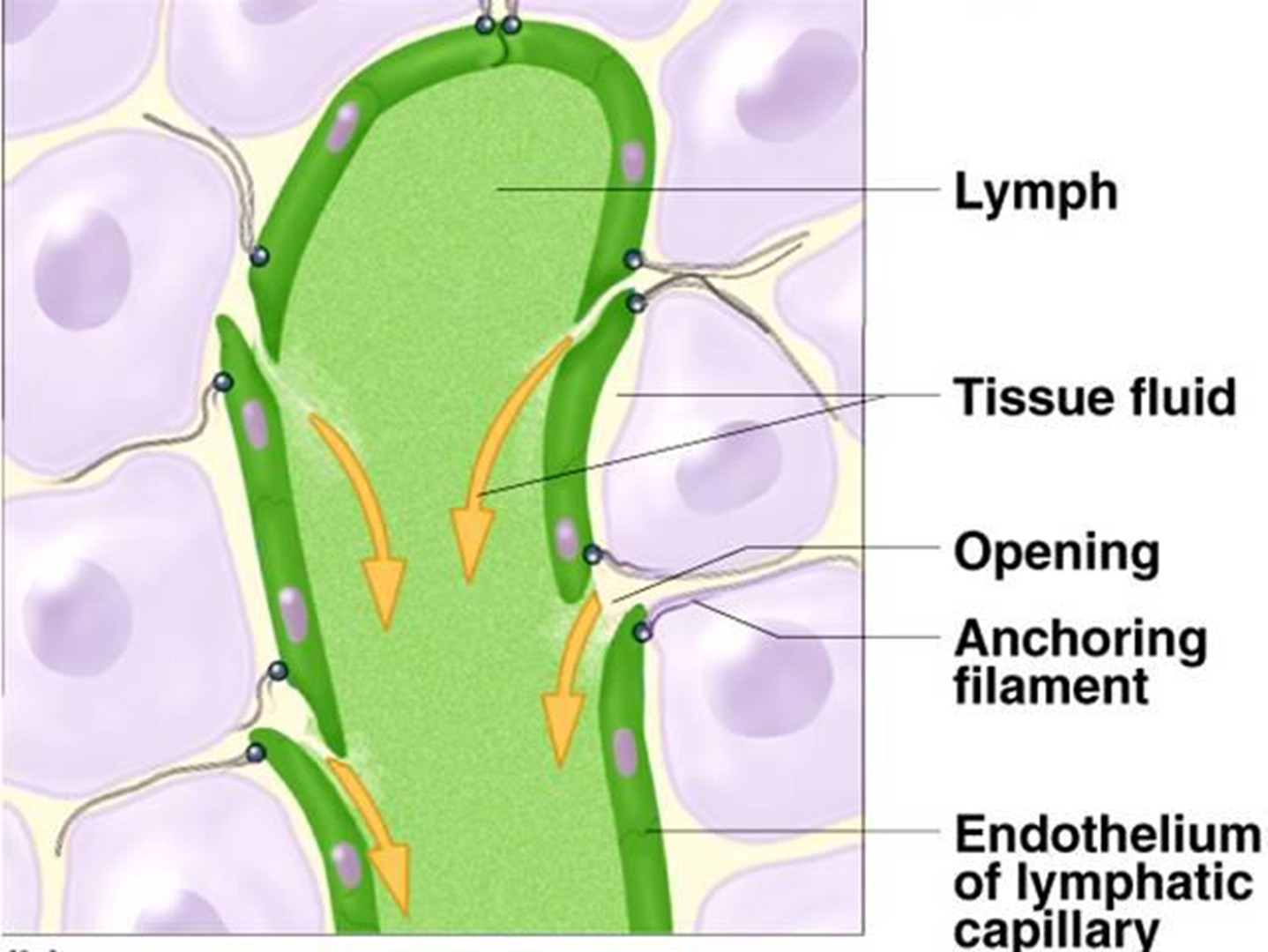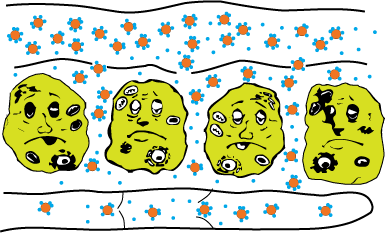Stay Informed
Popular Articles
- Hiatal Hernia: Hidden Cause of Chronic Illness
- Small Intestinal Bacterial Overgrowth (SIBO)
- Applied Lymphology: Unlocking the Secret to Pain Relief
- An Introduction to Constitutional Iridology
- The Low Down on Liver Detoxification
- An Energetic and Emotional Approach to Cancer
- Fat Facts
- Marrow in the Bones
- Blood Type and Nutrition
- Cardiac Herbs: Beyond Hawthorn
Quick Search
The School of Modern Herbal Medicine




Understanding Tissue Damage
- 4/8/2009
- Categorized in: General Health
This is page 2 of a four-part article.
Now, let's examine the conditions that exist when tissues get hurt. Every time we damage tissues (whether we bump them, cut them, scrape them, burn them, expose them to some poisonous substance, starve them, etc.), they respond in the same way. The cellular response to damage is a process called inflammation.
 Damaged cells release chemicals into the fluid surrounding the cells. One of the substances that escapes from the damaged cells is called histamine; another is bradykinin. Histamine and bradykinin cause the capillary pores to enlarge, which allows the blood proteins to escape into the tissue spaces. Since these proteins attract water, they draw large amounts of fluid into the tissue spaces. This creates swelling.
Damaged cells release chemicals into the fluid surrounding the cells. One of the substances that escapes from the damaged cells is called histamine; another is bradykinin. Histamine and bradykinin cause the capillary pores to enlarge, which allows the blood proteins to escape into the tissue spaces. Since these proteins attract water, they draw large amounts of fluid into the tissue spaces. This creates swelling.
We've all seen this happen. We've bumped our head or been bitten or stung by an insect and watched the area around the injury swell. The swelling is due to the plasma proteins leaking into the spaces around the cells (interstitial spaces) and drawing fluid out of the bloodstream.
One of the proteins that leaves the blood stream is fibrinogen. This large protein is responsible for blood clots. Under normal conditions, the electrical fields surrounding the cells keep fibrinogen and the other plasma proteins in suspension. However, at the site of an injury, as cells begin to suffer a loss of oxygen and nutrients, cellular energy diminishes. This causes fibrinogen and the other proteins to clump together. In a cut, this stops the bleeding by creating a mesh that catches red blood cells to form a blood clot. In the interstitial spaces, this clotting of protein causes fluid to accumulate around the cells, which turns the normal biological terrain into a swamp. Oxygen and nutrient exchange diminishes and waste accumulates.
The same conditions that occur when we have been sitting too long have just been created on a massive scale, so our cells start complaining loudly. We experience that complaining as pain. Pain is the distress call of our tissues. When excess fluid accumulates in the tissue spaces the cells are “drowning” in fluid and waste and calling for us to throw them a life preserver.
The following is the illustration I use to show “unhappy” cells that are suffering from excess fluid accumulation and poor lymphatic drainage. This shows what happens when tissues become irritated or inflamed. If these conditions remain for very long, the tissue becomes stagnant or swampy and subacute inflammation sets in. Over time, tissue function becomes depressed and cells eventually die leading to chronic and degenerative disease.

When we understand that pain is generally a signal that there is a lack of oxygen and an increase in toxicity in the tissues spaces, we know what we need to do to answer the distress call. If we can restore the normal circulation of blood and lymph, we can restore oxygen supply to the tissues and drain away waste, thus removing the CAUSE of the pain.
Unfortunately, most people are not concerned about dealing with the cause of the pain. They just want to remove the effect, i.e., make their cells quit complaining. That's why pain killers are so popular. Pain killers work by interfering with the signals our cells relay to the brain that there is a problem. This lets us pretend that nothing is wrong.
Pain is a Warning Signal
Think of pain as a warning light in your car telling you that something is wrong with the engine. That blinking “check engine soon” light is annoying us and we're just too busy to go the mechanic to have the car checked out. So, to solve our problem we cut the wires—no more annoying light.
Of course, anyone with half a brain can see that this wouldn't solve our engine problem and, by ignoring the early warning signs that something is wrong, we're setting ourselves up for an even worse problem down the road. Still, that's what many of us do with our bodies. We've been trained to assume that headaches, stomachaches, muscle pains, stiff necks, etc. are just natural parts of life, so we take pain killers so we can live with them.
But the body doesn't usually complain without good reason. Pain is telling us that tissues are being damaged and we should be concerned and ask ourselves “what is damaging my body?” It is almost like we are touching a hot stove over and over again and getting burned again and again and we are being told, “It is natural to get burned, an unavoidable part of life. Just take this pain killer for it and do your best to live with it.” But we don't have to “live with it.”
We just have to figure out what is causing the damage and stop doing it.
Meanwhile, let's focus on how we can reverse the damage and thus relieve the cause of pain. The beautiful secret is that we all instinctively know how to relieve pain. So, we're just going to learn to deliberately apply what we instinctively know.
Have you ever hit one of your fingers with a hammer, slammed it in a door or otherwise “smashed” it? Besides letting out a few cuss words, what was your first reaction? You probably grabbed it, didn't you? Your instincts were telling you exactly what to do. You were applying pressure.
You can't blow up a balloon while someone is squeezing it, can you? In the same manner, fluid cannot accumulate in a damaged area when pressure is being applied. So, applying pressure is the first secret of pain relief. The key to making pressure work is…
…DON'T LET GO.
Next time you smash your finger or injure yourself in some other manner and find yourself instinctively grabbing that injured part, just keep holding on until the pain subsides. This normally takes between five and twenty minutes.
Once the pain subsides you can let go and there will be no more pain. You have prevented inflammation from setting in by preventing fluid and protein from becoming trapped in the tissue spaces. This allows cellular energy fields to stay activated, preventing protein from clotting and creating a swamp.
Once the lymphatic system has drained the “debris” from the site of injury, there is no more cause of pain. Thousands of people have learned this secret and successfully applied it to smashed fingers, bumps, burns, cuts and other minor injuries.
Of course, we don't always get to an injury right away and the swelling has already occurred. In other cases, the injury is in a place where the application of pressure is impossible. That's OK, because we still know what needs to happen in order for healing to take place. We have to move fluid out the tissue spaces via the lymphatics to keep the swelling down so the injury can heal more quickly.
